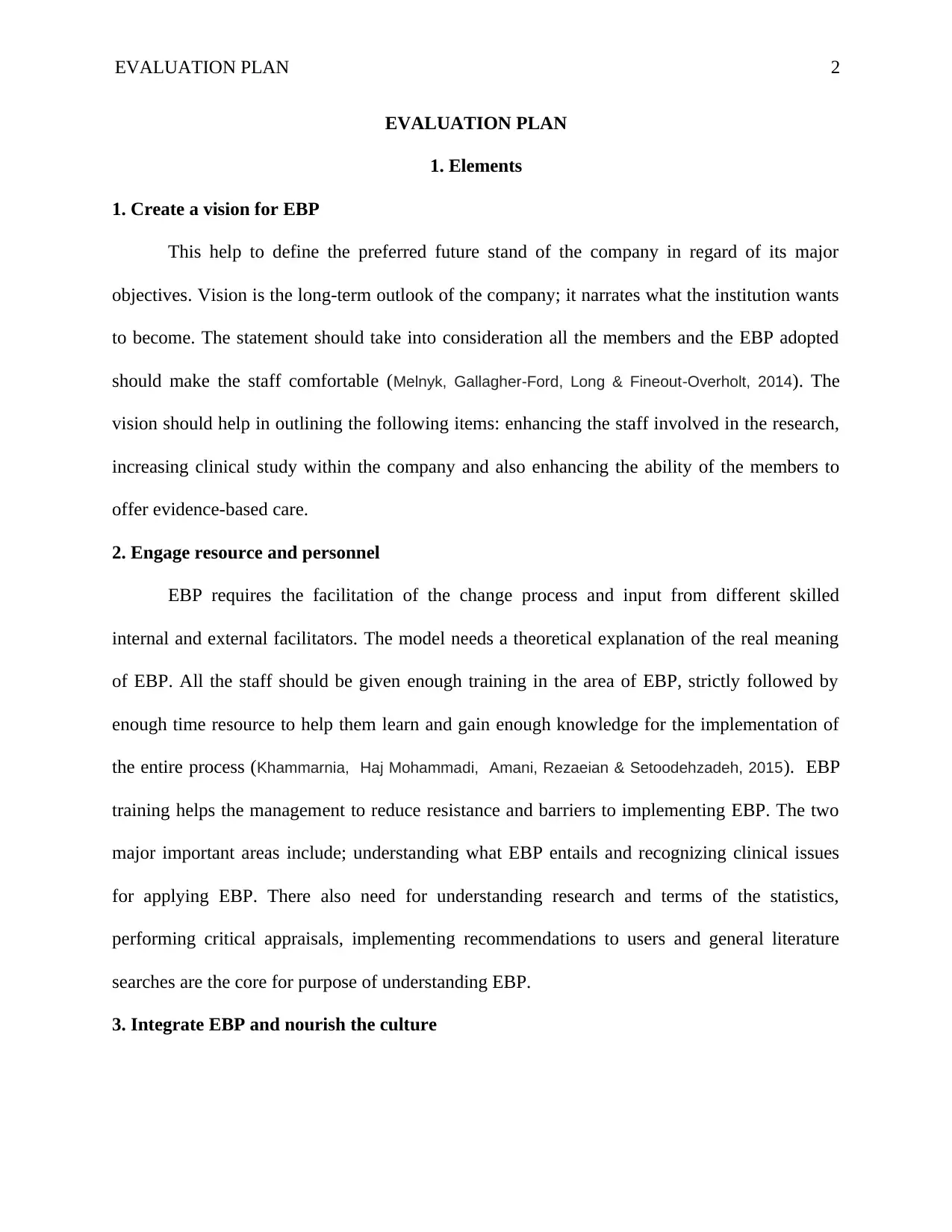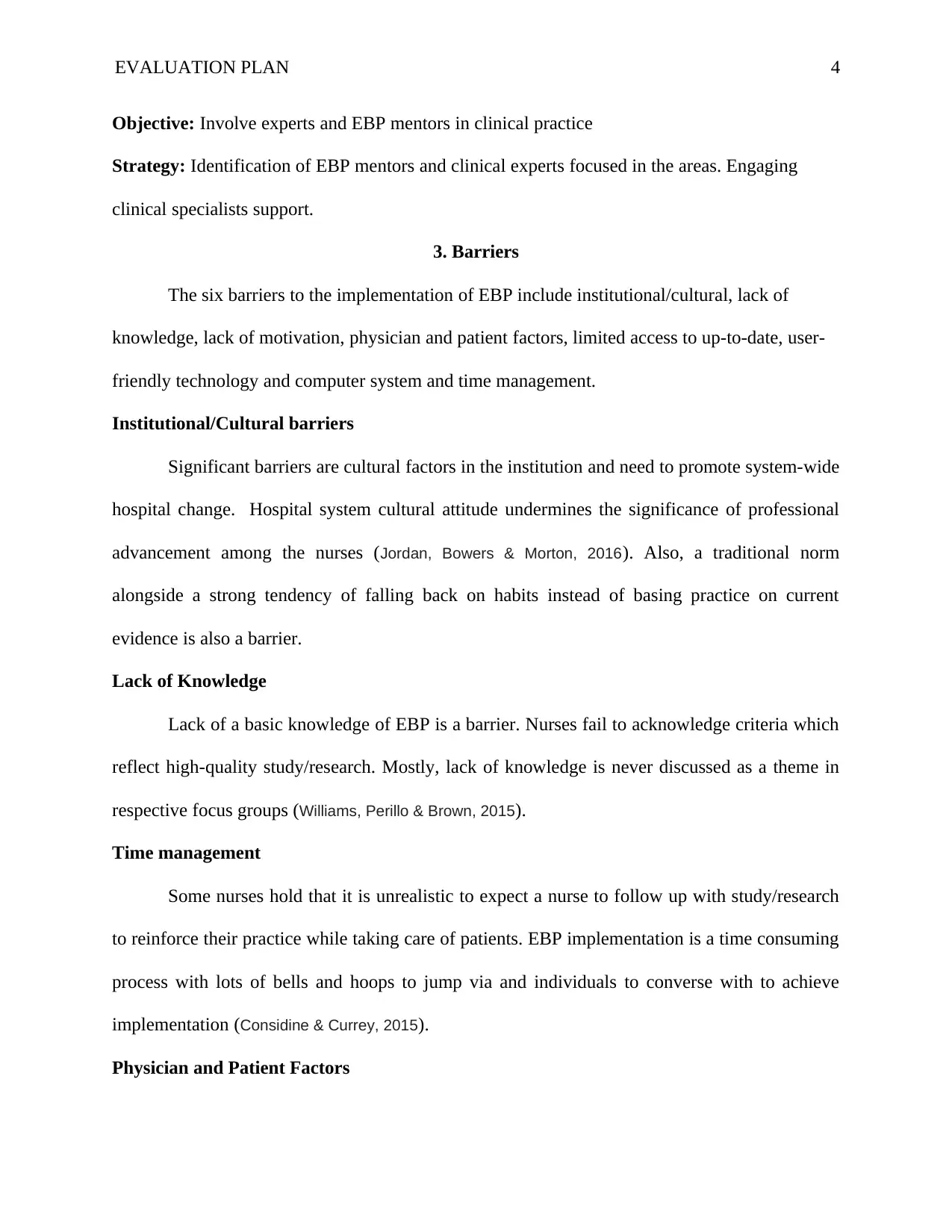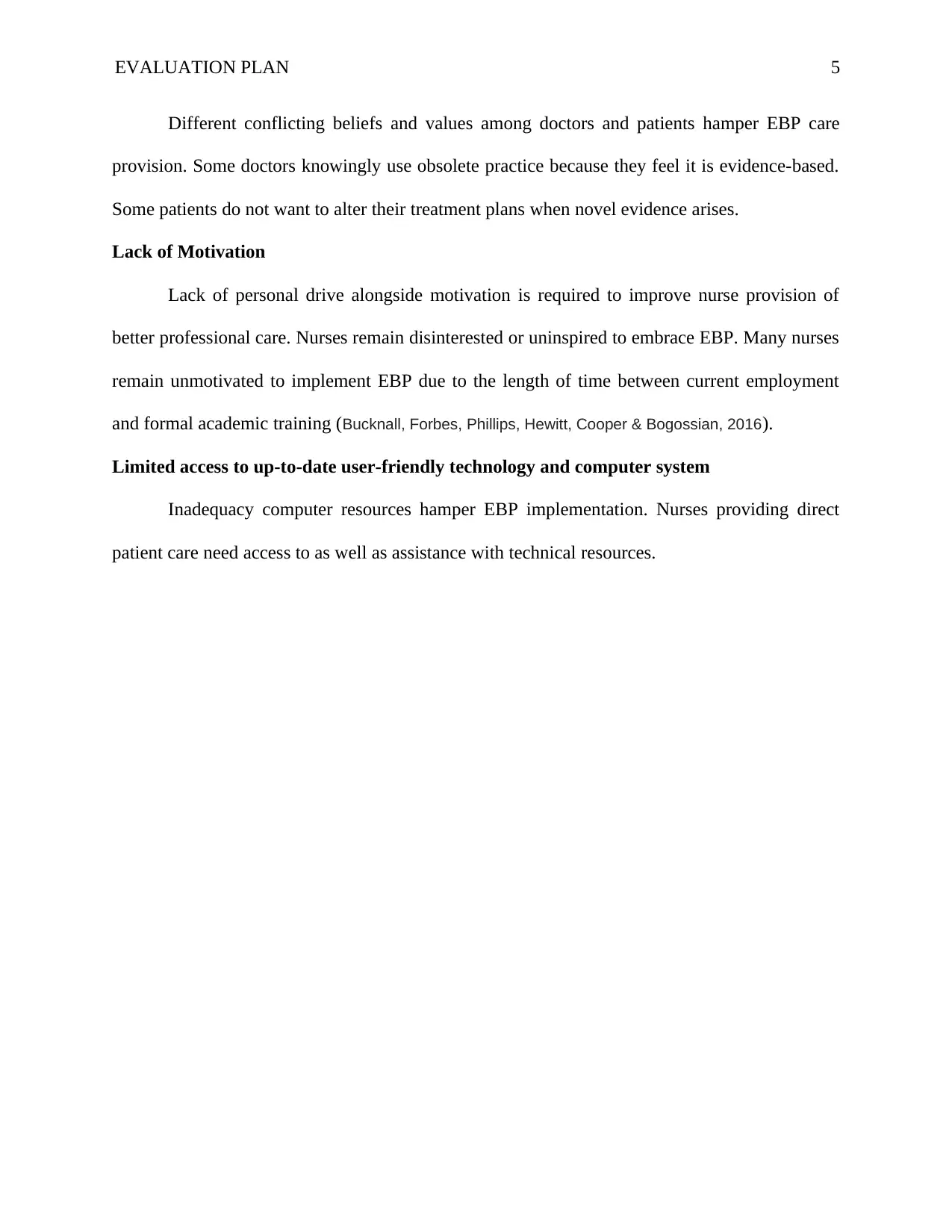Developing an Evaluation Plan for Evidence-Based Practice (EBP)
VerifiedAdded on 2023/06/15
|6
|1249
|382
Report
AI Summary
This report provides a comprehensive evaluation plan for implementing evidence-based practice (EBP) within a healthcare setting. It details key elements such as creating a vision for EBP, engaging resources and personnel, integrating EBP into the organizational culture, and evaluating the evidence. The report outlines specific objectives and strategies for developing a mental framework, establishing a motivating image for change, creating specific goals, gaining administrative support, establishing a leadership team, and involving experts and EBP mentors in clinical practice. Furthermore, it identifies and discusses six major barriers to EBP implementation: institutional/cultural factors, lack of knowledge, time management, physician and patient factors, lack of motivation, and limited access to technology and computer systems.

Running head: EVALUATION PLAN 1
Evaluation Plan
Name
Institution
Evaluation Plan
Name
Institution
Paraphrase This Document
Need a fresh take? Get an instant paraphrase of this document with our AI Paraphraser

EVALUATION PLAN 2
EVALUATION PLAN
1. Elements
1. Create a vision for EBP
This help to define the preferred future stand of the company in regard of its major
objectives. Vision is the long-term outlook of the company; it narrates what the institution wants
to become. The statement should take into consideration all the members and the EBP adopted
should make the staff comfortable (Melnyk, Gallagher‐Ford, Long & Fineout‐Overholt, 2014). The
vision should help in outlining the following items: enhancing the staff involved in the research,
increasing clinical study within the company and also enhancing the ability of the members to
offer evidence-based care.
2. Engage resource and personnel
EBP requires the facilitation of the change process and input from different skilled
internal and external facilitators. The model needs a theoretical explanation of the real meaning
of EBP. All the staff should be given enough training in the area of EBP, strictly followed by
enough time resource to help them learn and gain enough knowledge for the implementation of
the entire process (Khammarnia, Haj Mohammadi, Amani, Rezaeian & Setoodehzadeh, 2015). EBP
training helps the management to reduce resistance and barriers to implementing EBP. The two
major important areas include; understanding what EBP entails and recognizing clinical issues
for applying EBP. There also need for understanding research and terms of the statistics,
performing critical appraisals, implementing recommendations to users and general literature
searches are the core for purpose of understanding EBP.
3. Integrate EBP and nourish the culture
EVALUATION PLAN
1. Elements
1. Create a vision for EBP
This help to define the preferred future stand of the company in regard of its major
objectives. Vision is the long-term outlook of the company; it narrates what the institution wants
to become. The statement should take into consideration all the members and the EBP adopted
should make the staff comfortable (Melnyk, Gallagher‐Ford, Long & Fineout‐Overholt, 2014). The
vision should help in outlining the following items: enhancing the staff involved in the research,
increasing clinical study within the company and also enhancing the ability of the members to
offer evidence-based care.
2. Engage resource and personnel
EBP requires the facilitation of the change process and input from different skilled
internal and external facilitators. The model needs a theoretical explanation of the real meaning
of EBP. All the staff should be given enough training in the area of EBP, strictly followed by
enough time resource to help them learn and gain enough knowledge for the implementation of
the entire process (Khammarnia, Haj Mohammadi, Amani, Rezaeian & Setoodehzadeh, 2015). EBP
training helps the management to reduce resistance and barriers to implementing EBP. The two
major important areas include; understanding what EBP entails and recognizing clinical issues
for applying EBP. There also need for understanding research and terms of the statistics,
performing critical appraisals, implementing recommendations to users and general literature
searches are the core for purpose of understanding EBP.
3. Integrate EBP and nourish the culture

EVALUATION PLAN 3
EBP is a process that requires enough time for full implementation in the organization,
nurses and other staff members need to identify clinical issues and ensuring that EBP is in line
with the culture of the organization.
4. Evaluate the evidence
The organization should then evaluate the model and ensure that it performs towards
fulfilling organization’s goals put in place. EBP should be efficient and effective and enhances
the performances of every member of the staff.
2. Objectives and Strategies
Objective: Develop a mental framework
Strategy: Developing a written summary of what is to be achieved. Brainstorming will staff
about the environment to be created.
Objective: Establish a motivating image for change
Strategy: Utilizing creativity for capturing clinical staff’s attention. Taking advantage of actual
clinical scenarios to emphasize the necessity for practice changes is another strategy.
Objective: Create specific goals
Strategy: Focusing on short-run, achievable goals and establishing solely 2-3 goals at a go.
Objective: Gain administrative support
Strategy: Contacting responsible administrators for clinical practice. Another strategy is creating
a presentation which denotes the need for transforming the culture into Evidence-based practice
surrounding. Seeking administrators accountable for clinical practice is required.
Objective: Establish a leadership team
Strategy: Identification of central personnel with EBP’s passion. Conducting a small focus-
group discussion/meeting is required.
EBP is a process that requires enough time for full implementation in the organization,
nurses and other staff members need to identify clinical issues and ensuring that EBP is in line
with the culture of the organization.
4. Evaluate the evidence
The organization should then evaluate the model and ensure that it performs towards
fulfilling organization’s goals put in place. EBP should be efficient and effective and enhances
the performances of every member of the staff.
2. Objectives and Strategies
Objective: Develop a mental framework
Strategy: Developing a written summary of what is to be achieved. Brainstorming will staff
about the environment to be created.
Objective: Establish a motivating image for change
Strategy: Utilizing creativity for capturing clinical staff’s attention. Taking advantage of actual
clinical scenarios to emphasize the necessity for practice changes is another strategy.
Objective: Create specific goals
Strategy: Focusing on short-run, achievable goals and establishing solely 2-3 goals at a go.
Objective: Gain administrative support
Strategy: Contacting responsible administrators for clinical practice. Another strategy is creating
a presentation which denotes the need for transforming the culture into Evidence-based practice
surrounding. Seeking administrators accountable for clinical practice is required.
Objective: Establish a leadership team
Strategy: Identification of central personnel with EBP’s passion. Conducting a small focus-
group discussion/meeting is required.
⊘ This is a preview!⊘
Do you want full access?
Subscribe today to unlock all pages.

Trusted by 1+ million students worldwide

EVALUATION PLAN 4
Objective: Involve experts and EBP mentors in clinical practice
Strategy: Identification of EBP mentors and clinical experts focused in the areas. Engaging
clinical specialists support.
3. Barriers
The six barriers to the implementation of EBP include institutional/cultural, lack of
knowledge, lack of motivation, physician and patient factors, limited access to up-to-date, user-
friendly technology and computer system and time management.
Institutional/Cultural barriers
Significant barriers are cultural factors in the institution and need to promote system-wide
hospital change. Hospital system cultural attitude undermines the significance of professional
advancement among the nurses (Jordan, Bowers & Morton, 2016). Also, a traditional norm
alongside a strong tendency of falling back on habits instead of basing practice on current
evidence is also a barrier.
Lack of Knowledge
Lack of a basic knowledge of EBP is a barrier. Nurses fail to acknowledge criteria which
reflect high-quality study/research. Mostly, lack of knowledge is never discussed as a theme in
respective focus groups (Williams, Perillo & Brown, 2015).
Time management
Some nurses hold that it is unrealistic to expect a nurse to follow up with study/research
to reinforce their practice while taking care of patients. EBP implementation is a time consuming
process with lots of bells and hoops to jump via and individuals to converse with to achieve
implementation (Considine & Currey, 2015).
Physician and Patient Factors
Objective: Involve experts and EBP mentors in clinical practice
Strategy: Identification of EBP mentors and clinical experts focused in the areas. Engaging
clinical specialists support.
3. Barriers
The six barriers to the implementation of EBP include institutional/cultural, lack of
knowledge, lack of motivation, physician and patient factors, limited access to up-to-date, user-
friendly technology and computer system and time management.
Institutional/Cultural barriers
Significant barriers are cultural factors in the institution and need to promote system-wide
hospital change. Hospital system cultural attitude undermines the significance of professional
advancement among the nurses (Jordan, Bowers & Morton, 2016). Also, a traditional norm
alongside a strong tendency of falling back on habits instead of basing practice on current
evidence is also a barrier.
Lack of Knowledge
Lack of a basic knowledge of EBP is a barrier. Nurses fail to acknowledge criteria which
reflect high-quality study/research. Mostly, lack of knowledge is never discussed as a theme in
respective focus groups (Williams, Perillo & Brown, 2015).
Time management
Some nurses hold that it is unrealistic to expect a nurse to follow up with study/research
to reinforce their practice while taking care of patients. EBP implementation is a time consuming
process with lots of bells and hoops to jump via and individuals to converse with to achieve
implementation (Considine & Currey, 2015).
Physician and Patient Factors
Paraphrase This Document
Need a fresh take? Get an instant paraphrase of this document with our AI Paraphraser

EVALUATION PLAN 5
Different conflicting beliefs and values among doctors and patients hamper EBP care
provision. Some doctors knowingly use obsolete practice because they feel it is evidence-based.
Some patients do not want to alter their treatment plans when novel evidence arises.
Lack of Motivation
Lack of personal drive alongside motivation is required to improve nurse provision of
better professional care. Nurses remain disinterested or uninspired to embrace EBP. Many nurses
remain unmotivated to implement EBP due to the length of time between current employment
and formal academic training (Bucknall, Forbes, Phillips, Hewitt, Cooper & Bogossian, 2016).
Limited access to up-to-date user-friendly technology and computer system
Inadequacy computer resources hamper EBP implementation. Nurses providing direct
patient care need access to as well as assistance with technical resources.
Different conflicting beliefs and values among doctors and patients hamper EBP care
provision. Some doctors knowingly use obsolete practice because they feel it is evidence-based.
Some patients do not want to alter their treatment plans when novel evidence arises.
Lack of Motivation
Lack of personal drive alongside motivation is required to improve nurse provision of
better professional care. Nurses remain disinterested or uninspired to embrace EBP. Many nurses
remain unmotivated to implement EBP due to the length of time between current employment
and formal academic training (Bucknall, Forbes, Phillips, Hewitt, Cooper & Bogossian, 2016).
Limited access to up-to-date user-friendly technology and computer system
Inadequacy computer resources hamper EBP implementation. Nurses providing direct
patient care need access to as well as assistance with technical resources.

EVALUATION PLAN 6
References
Bucknall, T. K., Forbes, H., Phillips, N. M., Hewitt, N. A., Cooper, S., & Bogossian, F. (2016). An analysis
of nursing students’ decision‐making in teams during simulations of acute patient
deterioration. Journal of advanced nursing, 72(10), 2482-2494.
Considine, J., & Currey, J. (2015). Ensuring a proactive, evidence‐based, patient safety approach to
patient assessment. Journal of clinical nursing, 24(1-2), 300-307.
Jordan, P., Bowers, C., & Morton, D. (2016). Barriers to implementing evidence-based practice in a
private intensive care unit in the Eastern Cape. Southern African Journal of Critical Care
(Online), 32(2), 50-54.
Khammarnia, M., Haj Mohammadi, M., Amani, Z., Rezaeian, S., & Setoodehzadeh, F. (2015). Barriers to
implementation of evidence based practice in Zahedan teaching hospitals, Iran, 2014. Nursing
research and practice, 2015.
Melnyk, B. M., Gallagher‐Ford, L., Long, L. E., & Fineout‐Overholt, E. (2014). The establishment of
evidence‐based practice competencies for practicing registered nurses and advanced practice
nurses in real‐world clinical settings: proficiencies to improve healthcare quality, reliability, patient
outcomes, and costs. Worldviews on Evidence
‐Based Nursing, 11(1), 5-15.
Williams, B., Perillo, S., & Brown, T. (2015). What are the factors of organisational culture in health care
settings that act as barriers to the implementation of evidence-based practice? A scoping
review. Nurse education today, 35(2), e34-e41.
References
Bucknall, T. K., Forbes, H., Phillips, N. M., Hewitt, N. A., Cooper, S., & Bogossian, F. (2016). An analysis
of nursing students’ decision‐making in teams during simulations of acute patient
deterioration. Journal of advanced nursing, 72(10), 2482-2494.
Considine, J., & Currey, J. (2015). Ensuring a proactive, evidence‐based, patient safety approach to
patient assessment. Journal of clinical nursing, 24(1-2), 300-307.
Jordan, P., Bowers, C., & Morton, D. (2016). Barriers to implementing evidence-based practice in a
private intensive care unit in the Eastern Cape. Southern African Journal of Critical Care
(Online), 32(2), 50-54.
Khammarnia, M., Haj Mohammadi, M., Amani, Z., Rezaeian, S., & Setoodehzadeh, F. (2015). Barriers to
implementation of evidence based practice in Zahedan teaching hospitals, Iran, 2014. Nursing
research and practice, 2015.
Melnyk, B. M., Gallagher‐Ford, L., Long, L. E., & Fineout‐Overholt, E. (2014). The establishment of
evidence‐based practice competencies for practicing registered nurses and advanced practice
nurses in real‐world clinical settings: proficiencies to improve healthcare quality, reliability, patient
outcomes, and costs. Worldviews on Evidence
‐Based Nursing, 11(1), 5-15.
Williams, B., Perillo, S., & Brown, T. (2015). What are the factors of organisational culture in health care
settings that act as barriers to the implementation of evidence-based practice? A scoping
review. Nurse education today, 35(2), e34-e41.
⊘ This is a preview!⊘
Do you want full access?
Subscribe today to unlock all pages.

Trusted by 1+ million students worldwide
1 out of 6
Related Documents
Your All-in-One AI-Powered Toolkit for Academic Success.
+13062052269
info@desklib.com
Available 24*7 on WhatsApp / Email
![[object Object]](/_next/static/media/star-bottom.7253800d.svg)
Unlock your academic potential
Copyright © 2020–2025 A2Z Services. All Rights Reserved. Developed and managed by ZUCOL.





